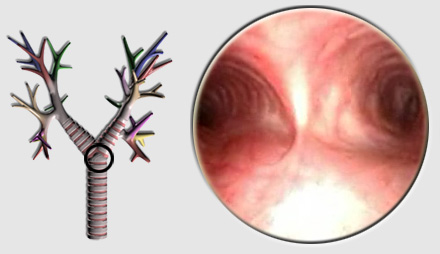Indications:
This is a flinch-diagnose lung disease before clinical symptoms unexplained or a radiological image to be determined.
Principle:
The flexible endoscope to visualize the bronchial tree; he can practice aspirations in case of obstructions and biopsies guided by the vision of abnormal areas or systematic in doubt bronchial hull.
Endoscopy can be used to extract a intrabronchial foreign body.
 Cons-indications:
Cons-indications:
Known allergy to the autopsy or to local anesthetics.
A study of hemostasis is required.
Severe respiratory failure is not in itself an indication-cons, the review can be practiced under ventilatory support and oxygen therapy.
Technique:
The examination can be performed without hospitalization.
X-rays of the lungs, front and profile, must have been completed.
Tobacco must be stopped for at least 36 hours.
Local anesthesia with lidocaine is made after slight premedication; general anesthesia is possible.
After introduction, the nasal or oral endoscope, is performed according to the observations:
– Suction of secretions;
– Biopsies of lesions;
– Bacteriological samples in case of suspected infection;
– Lavage.
Results:
Visual diagnosis supplemented by histological results allows to initiate treatment tailored to the characteristics of lesions observed.
Incidents:
Laryngospasm (which prevents the introduction of the endoscope in an agitated patient), bronchospasm, dysphonia persisting few days.
Pneumothorax during biopsy, hemoptysis.
Cost:
K30 + B75 if aspiration or biopsy.
K50 + B150 if aspiration and biopsy.
Practical advice:
During the exam, verify the absence of cyanosis and good tolerance of the examination. Interestingly, in the result of the review, in case of doubt about cancer, collect sputum for cytological analysis.
In the aftermath of the act, especially if it involved a bronchoalveolar lavage, a temperature shift can be observed, should not persist more than a few days.
After the endoscopy, the patient remains under surveillance and fasting for two hours, because there is a risk of aspiration induced local anesthesia. Warn the patient that it is possible that he spits blood.

Leave a Reply